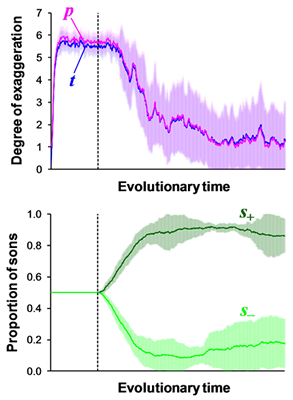Sex ratio control erodes sexual selection
How much animals should invest in sons and daughters is a central problem in behavioural ecology. In 1973, Bob Trivers and Dan Willard suggested that parents should bias offspring sex ratios in relation to certain environmental factors, if those factors influence the fitness of sons and daughters differently. One influential idea is that females mated to attractive partners should overproduce sons, since these sons will inherit their father's attractiveness and so enjoy high mating success. This has been investigated mainly in birds, where males typically have elaborate courtship displays and females, with two different sex chromosomes, potentially have some control over offspring sex. But while some studies have reported a link between male attractiveness and brood sex ratios, others have found no such relationship. In the past, we developed theory to achieve a better understanding of these experimental results. We could show that the above-mentioned verbal arguments are generally correct, but that the relationship between sex ratio bias and father’s attractiveness should reflect the genetic architecture of the sexually selected traits.
In a recent article (Fawcett et al., PNAS, in press) we add another twist to the story. This is illustrated by Figure 1. We performed individual-based simulations for various standard models of sexual selection. As shown in the initial time period in Figure 1 (up to the dashed line), female preferences and male ornamentation evolve to the theoretically predicted equilibrium. In the initial period, the sex ratio was fixed at 0.5, but from this point onwards, it was allowed to evolve. As shown in the figure, a strong sex ratio bias evolves where females mated to attractive partners indeed overproduce sons, while females mated to less attractive males overproduce daughters. Intriguingly, the sex ratio bias has strong repercussions on sexual selection, that is, on the very same process driving its evolution. As shown in the upper panel of Figure 1, the evolved sex ratio bias leads to a reduction in both female preferences and male ornamentation.

Two main processes are responsible for the erosion of sexual selection by sex-ratio control. First, sex-ratio adjustment allows females with unattractive partners to mitigate the fitness disadvantage of low male ornamentation. In simple terms, ending up with an unattractive male is not so disastrous if a female can skew offspring production towards daughters. This reduces the fitness benefit of female choosiness. Second, since choosier females tend to mate with more ornamented males and therefore produce mainly sons, their strong preference genes will rarely be expressed by their offspring. This lowers the average female preference in subsequent generations and thereby reduces the fitness benefit of male ornamentation. Consequently, the equilibrium levels of female preference and male ornamentation are substantially lower when sex-ratio adjustment is possible. In effect, sex ratio control undermines the very process that selected for it in the first place. Our model predicts that the most elaborate ornamentation should be seen in species with little control over the sex ratio.
By means of a simple but generic analytical model, we could demonstrate that the outcome of our individual-based simulations is robust and general. Moreover, the feedback described above points to a more general evolutionary principle, in which a conditional strategy weakens directional selection on another trait by reducing fitness differences.
